

Mexican American Professionals Finally Have An Online Home
Mexican American Pro Archives website, mexican-american-proarchive.com, is dedicated to sharing articles and pertinent information on “the silent minority.”
SAN FRANCISCO, May 3, 2009 – Lack of centralized information on “the silent minority” inspired, Humberto Gutierrez, to establish mexican-american-proarchive.com as a resource dedicated to tracking the progress of Mexican American Professionals in the U.S.
The website includes original content from Mr. Gutierrez, a Mexican American writer and educator, but also encourages readers to post information relevant to the topic. Gutierrez “hopes the site will become an archive and resource of information to facilitate the distribution of information which impacts Mexican American Professionals.”
Gutierrez stresses that there is a significant lack of serious research on the Mexican American Professional demographic. He came to this realization about fives years ago after an unsuccessful attempt to find reliable information on the topic.
Gutierrez’s quest for information prompted “The Silent Minority: Mexican American Professionals. An Odyssey in Search of Elusive data.” The article, published in Hispanic Outlook in Higher Education Magazine on July 28 2003, discusses the lack of reliable data on Mexican American Professionals.
Since publishing the article, Gutierrez has acquired updated information. Latest numbers from the Census Bureau’s 2007 American Community Survey show that Mexican American college graduates are greatly underrepresented when compared to other Hispanics.
Mexican Americans have and are still relegated to tired stereotypes of drug traffickers, lovers and service workers. The Mexican American community numbers close to 30 million, roughly 10% of our total population. The Mexican American Community is represented by a wide variety of persons including professionals. As a group, Mexican American professionals have been largely ignored by the news media. Recent numbers show that Mexican American College graduates represent only 6.2 % of their total population. This compares with 29.4% for Non-Hispanic graduates.
Mexican Americans are the lowest in educational attainment among Hispanics. Compared with other Foreign Born groups, Mexican Americans do even worse. For example, college graduates from Mexico represent 5.2% of their total population. In comparison, Indian college graduates have a 74.1% representation.
About mexican-american-proarchive.com:
Mexican American Pro Archives (https://www.mexican-american-proarchive.com) is dedicated to archiving information about Mexican American Professionals. Creator and administrator, Humberto Gutierrez, was born in Chihuahua Mexico and relocated to the United States as a teenager. Gutierrez has been an educator and writer for over 35 years. Please contact to request more information.
Contact:
Humberto Gutierrez, Administrator
Mexican American Pro Archives
Phone: 650-738-8584
betooliv@comcast.net
The Silent Minority: Mexican-American Professionals
At last, some data
Humberto (Tito) Gutierrez
Since I wrote the first article about Mexican-American Professionals, the Census Bureau has created The American Community Survey (ACS). It …”is part of the Decennial Census Program. It is a survey that is sent to a small percentage of our population on a rotating basis. This data was previously collected only in census years in conjunction with the decennial census. Since the ACS is conducted every year, rather than once every ten years, it will provide more current data…” Given this fact, statistical information about Mexican-Americans is much more current and precise.
Why should we care?
From the year 2,000 to the present, Mexicans 25 years and older had the lowest proportion of Hispanics with a bachelor’s degree or more.
Census Bureau 2000 Demographic Profile characteristics: Race, ethnic, or ancestry group.
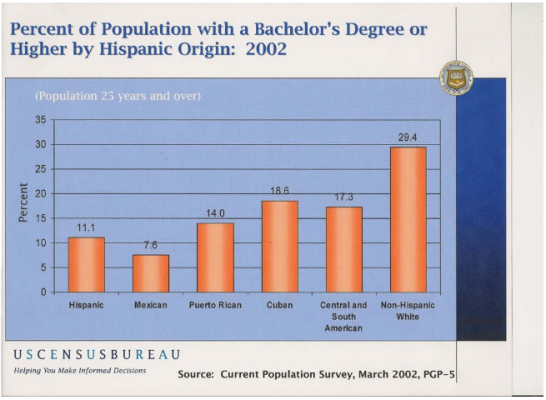
Then and now: Have Mexican- American Professionals grown in numbers since 2004?
The answer is yes, but not by much.
- In 1985 the educational attainment of Mexican-Americans 25 years or older was 5.5%
- In 1989 it was 6.1%
- In 2,000 it was 7%
- In 2002 it was 7.6%
- During the years 2005 to 2007 it was 6.0%
- In 2007 it was 6.2%
You may ask; why did the numbers drop from 2002 to 2005?
The reason is that these are percentages of the total Mexican- American population which in:
- 2002 numbered 25.1 million
- 2005 numbered 28.1 million
- 2007 numbered 29.1 million
Between 2002 and 2005 there was an increase of 3 million Mexican-Americans, therefore the growth among Mexican-American college graduates had to increase by that proportional amount and obviously, it did not.
How do percentages of Mexican- American college graduate students compare with non-Hispanic groups? The chart below shows how the two groups compared in 2002.
Census Bureau 2005-2007 American Community Survey 3-Year Estimates.
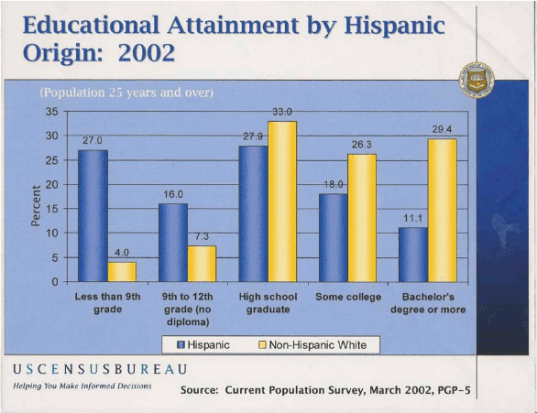
Other years we can compare the contrast between Mexican-American and Non-Hispanic groups that have attained a B.A. or more are:
In 1989 21.1 % of the non-Hispanic group had earned a B.A. or more, compared to 6.1 for Mexican-Americans.
- In 2,000 24.4% for non- Hispanics and 7% for Mexican-Americans.
- In 2,002 29% for non-Hispanics and 7.6% for Mexican Americans.
From 2005 to 2007 it was 27% for non-Hispanics and 6% for Mexican-Americans. The percentage of Non-Hispanic white is 29.4 compared with 11.1 for Hispanics and 7.6 for Mexicans.
Foreign born Mexican-American fared even worse. In 2007 Educational Attainment by Mexicans at the B.A. degree or more was only 5.2%.
Census Bureau, Foreign Born Population in the United States: 2003.
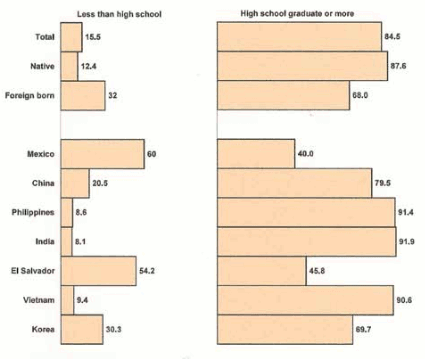
Educational Attainment by Nativity, Showing Countries of Birth of the Foreign-Born Population with 1 Million or More: 2007
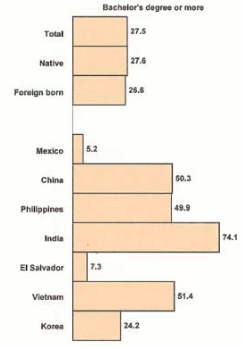
What are some reasons for the great discrepancy between Mexican-American and Mexican academic achievement and Non-Hispanic populations?
One possible explanation is that Mexican-Americans are mostly employed in service, precision, production, craft and transportation jobs. This means that both Mexican groups have limited economic resources to fund their college careers. To this point, the Hispanic-Serving Institution Program found in areas which service Hispanics, funds Hispanics who want to attend college. There is a statistical chart entitled “Location of Hispanic-Serving Institutions of Higher Education in the United States by State and Percentage of Latino Undergraduates Enrolled 2003 to 2004”. This data can be found at the National Center for Education Statistics IPEDS Survey 2003 to2004.
One last comment.
It is interesting to note that the level of students in Higher Education (Instruccion Superior) in Mexico for 25 to 30 year olds is 16% of the total Mexican population.
Los Jóvenes en México, Instituto de Estadística Geográfica e Informática. PDF file, starts on P174.
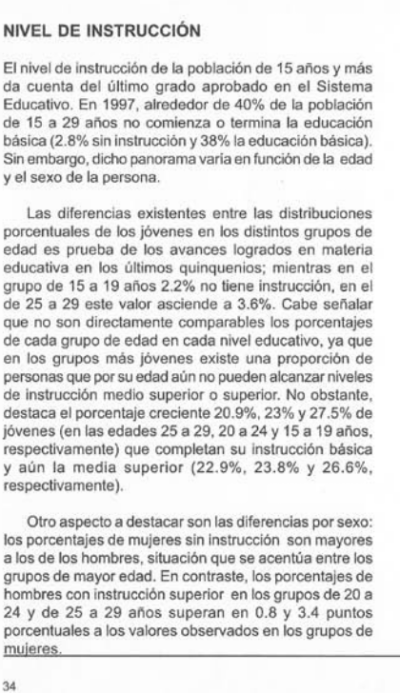
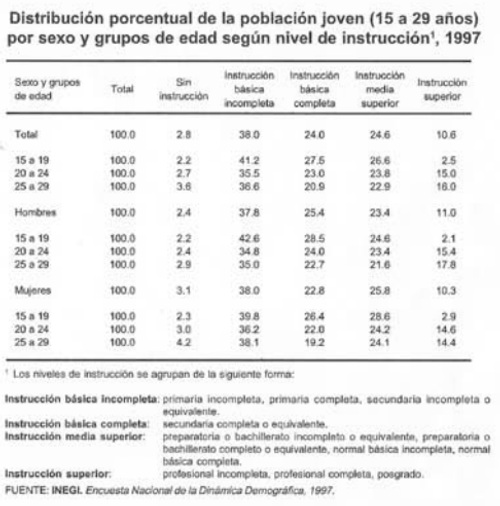
In summary:
We have made some progress filling in the gap between Mexican-American professionals (6.1% in 1989) to (6.2% in 2007) and Non-Hispanics which in 2007 number 27%. At this pace it would take Mexican-American 27 years to catch up with the Non-Hispanic population.
Sources:
- Census Bureau 2000 Demographic Profile characteristics: Race, ethnic, or ancestry group.
- Census Bureau 2005-2007 American Community Survey 3-Year Estimates.
- Census Bureau, Foreign Born Population in the United States: 2003. Slide show.
- Census Bureau, Social and Economic Characteristics of the Hispanic Population: 2006. Table 39.
- Los Jóvenes en México, Instituto de Estadística Geográfica e Informática. PDF file, starts on P174.
These PDF files are the complete documents, parts of which were used to write the above article.
- Census Bureau, Percent of Persons 25 Years Old and Over Who Have Completed High School or College, by Race Hispanic Origin and Sex: Selected Years 1940 to 1990. PDF file.
- Census Bureau, Hispanic Population in the United States: 2002. Current Population Reports. PDF file
- Census Bureau, Educational Attainment in the United States: 2003. PDF file.
Getting to Know You Better
Price: $.99
Publisher: Humberto (Tito) Gutierrez (August 31, 2008)
Editorial Reviews
Getting to Know You Better is an article written by a father, among the millions, whose children grew up with their mother. It is about his relationship with his grown daughter.
It is a warm hearted story of emotional growth for both individuals and a good insight into Generation X.
The writer explains how Generation X is not a homogeneous group and how they represent cynical disdainers, traditional materialists, hippies revisited and Fifties Machos.
Read this interesting analysis about parental relationships in the divorce age.
Ready to buy?
Click the BUY NOW button to order your copy via PayPal
(How to pay with PayPal or CC)
Mexican Professionals flee Drug War
Mexicans fleeing drug war help El Paso house market
Wed Sep 10, 2008 2:41pm EDT
EL PASO, Texas (Reuters) – Mexicans fleeing a gruesome drug war are buying homes across the border in El Paso, helping keep the Texan city’s property market afloat despite the worst U.S. housing crisis in decades.
With clashes between rival drug gangs leaving dead bodies on the streets of the Mexican border city of Ciudad Juarez almost daily, hundreds of middle class Mexicans are selling up and moving to El Paso, just over the Rio Grande.
The cities are a short walk apart, but there have been 12 homicides in El Paso this year compared to some 900 in Ciudad Juarez, where law and order has collapsed as Mexico’s most wanted man Joaquin “Shorty” Guzman battles local drug baron Vicente Carrillo Fuentes for U.S. smuggling routes.
The increase in the number of Mexican buyers has helped support El Paso’s housing market. While foreclosures hit a record high across the United States between April and June, El Paso estate agents report brisk sales of houses and apartments in the $80,000 to $300,000 range and broadly steady prices.
“Our market is not a plummeting market compared to the rest of the country,” said Dan Olivas, president of the Greater El Paso Association of Realtors.
“A lot of that is buoyed by a substantial number of people from Juarez coming over to buy properties for security reasons, for fear of kidnappings, extortion, cartel violence,” he said.
Already notorious for a spate of brutal murders of young women in the 1990s, Ciudad Juarez has become Mexico’s most violent city in a drug war that has killed some 2,700 people nationwide so far this year. Some 3,000 troops were sent to the city of 1.5 million but they have failed to stop the chaos.
El Paso real estate brokers say demand from over the border began rising early this year as the drug violence flared, and has ballooned since then as murders, abductions, extortions and car theft have spiraled. Many Mexicans are even paying cash.
Media Professionals adopt charter
Latin American Media Professionals Adopt the Charter of Guadalajara
The Charter of Guadalajara includes a set of recommendations addressed to the media, governments, civil society, universities and UNESCO. Among the most concrete ones addressed to UNESCO is the setting up of an Audio-Platform which, inspired by UNESCO’s E-platform, would gather under one single portal different audio archives for the use of radio stations in search of public service oriented content. To overcome the language barriers, the portal would be divided into different linguistic blocks
Michigan State launches new Ph.D Chicano Studies Program
MSU offers Midwest’s first Ph.D. in Chicano/Latino Studies
Contact: Andy Henion, University Relations, Office: (517) 355-3294, Cell: (517) 281-6949, Andy.Henion@ur.msu.edu
Published: Sept. 26, 2007
Story
EAST LANSING, Mich. — Michigan State University has launched the first doctoral program in Chicano/Latino Studies in the Midwest – and only the second in the nation.
The interdisciplinary graduate degree, which grew out of MSU’s undergraduate Chicano/Latino Studies program, is offered by the College of Social Science. Like many doctoral programs, it is starting small; five students are enrolled for the 2007-08 academic year.
Dionicio Valdes, program director and MSU professor of history, said the Chicano/Latino population is simultaneously the fastest-growing and least-studied major ethnic group in the United States. Hispanics are also the largest minority group at nearly 43 million people.
“This program is important for many reasons,” Valdes said. “But the biggest single reason is that it offers a much different approach to knowledge and an understanding of our increasingly complex society that academia has not yet come to terms with.”
Doctoral candidates will explore the historical and contemporary experiences of Chicanos and Latinos in social, cultural, political and economic contexts. Doctorate courses range from “Latina Feminisms” to “Globalization and Mexican Immigration to the United States.”
The University of California, Santa Barbara, offers the only other doctorate focusing specifically on Chicano studies.
Valdes said Michigan State’s relatively large number of Hispanic students and reputation for Chicano/Latino scholarship make the new doctoral program a logical fit. According to the provost’s office, 1,309 students are enrolled at MSU this fall – a 34 percent increase over 1997.
MSU also has the Cesar E. Chavez Collection, one of the nation’s largest library holdings representing the life and philosophy of the late civil rights activist and the Chicano/Latino community.
In addition, the Julian Samora Research Institute is located on campus. The institute, named after the former MSU professor and pioneer in Mexican-American studies, conducts research and projects targeting the needs of the Hispanic community in the areas of economic development, education, families and neighborhoods.
Rubén Martinez, who became the institute’s director on Sept. 1, said a deeper understanding of Chicano and Latino groups “will contribute to the betterment of the nation as a whole as it moves forward into the 21st century.”
“Previous scholarship has argued that the flow of Mexican and Latino immigrants into cities and states has coincided with their development and prosperity – both the people and the economies have benefitted,” Martinez said. “We see this in many communities in the South today, even though local institutions struggle to meet the educational and health needs of their newest community members.
“The scholarly work of doctoral students in the new program,” he added, “will enhance our understanding of these dynamics and ultimately contribute to the betterment of intergroup relations in this country.”
For more information on MSU’s doctoral program in Chicano/Latino Studies, visit www.msu.edu/~cls.
For more information on the Julian Samora Research Institute, visit www.jsri.msu.edu/.
For more information on MSU’s Cesar E. Chavez Collection, visit: www.lib.msu.edu/coll/main/chavez/.
###
UTEP awarded $13 million
GEAR UP awarded $13 million
The University of Texas at El Paso has been awarded more than $12.9 million from the Department of Education GEAR UP Program to help more than 3,000 area middle school students prepare for college.
Now in its fourth year at UTEP, the program is expected to receive $2.15 million each year during the next six years.
The award will fund UTEP’s Gaining Early Awareness and Readiness for Undergraduate Program (GEAR UP) where students from 11 Ysleta Independent School District middle schools are enrolled.
GEAR UP is a federal program that helps youth from low-income communities obtain a postsecondary education through tutoring programs, standardized testing preparation and other programs. The course was enacted as a result of Congress’ passage of the Higher Education Amendment of 1998 where students in grades 6-12 are encouraged to stay in school and apply for college.
Getting to Know You
Price: $.99
File Size: 59 KB
Publisher: Humberto (Tito) Gutierrez (August 31, 2008)
Editorial Reviews
This article is about the relationship between a non-custodial father and his grown daughters. It addresses with humor and candor the delicate dance of a loving, but out-of-the-house father starting a new relationship with his now adult daughters. Humberto’s description of a weekend spent with one of his daughters will make you chuckle and may bring a tear.
Ready to buy?
Click the BUY NOW button to order your copy via PayPal
(How to pay with PayPal or CC)
Buy at Amazon:
Start reading Getting to Know You by Humberto (Tito) Gutierrezon your Kindle in under a minute.
Electroluv
Price: $.99
File Size: 49 KB
Publisher: Humberto (Tito) Gutierrez (August 31, 2008)
Electroluv is an entertaining and sensuous story about Ed, a character out of the Greek classics, who does not want to know the truth about the relationship between his daughter and his second wife.
The setting is a small town in Northern California, well known for its pastoral beauty and peaceful way of life.
The story documents the struggles and aspirations of Mexican American Immigrants, a group that has largely been ignored by most fiction writers in this country.
Electroluv’s main character, Ed, is a High School Principal in Ukiah California, he crafts a definitive tale of the trials and tribulations of a single parent.
Helena, his beautiful and voluptuous wife, stirs the pot by betraying Ed’s trust.
This is an interesting and important tale that will excite your senses.
Ready to buy?
Click the BUY NOW button to order your copy via PayPal
(How to pay with PayPal or CC)
Buy at Amazon:
Start reading Electroluv by Humberto (Tito) Gutierrez on your Kindle in under a minute.
Dating after Fiftyish
Price: $.99
File Size: 52 KB
Publisher: Humberto (Tito) Gutierrez (August 31, 2008)
Editorial Reviews
Funny, funny article about dating after fifty.
This is a well researched article about baby boomers and others in search of a mate. It focuses on Internet dating but the scope of the article goes beyond just Internet dating.
This informative and humorous article describes the difficulties of finding a mate when time is short and the rules of the institution of marriage have changed.
The author describes, in some detail, his own experiences with Internet dating. His experiences are insightful and delightful. In addition his experiences make for great conversation.
The article also includes general characteristics of the fifty plus single, divorced, or widowed population.
His advice to prospective mates is honest and refreshing.
Ready to buy?
Click the BUY NOW button to order your copy via PayPal
(How to pay with PayPal or CC)
Buy at Amazon:
Start reading Dating after Fiftyish by Humberto (Tito) Gutierrezon your Kindle in under a minute.
Poems by Humberto (Tito) Gutierrez
Price: $.99
File Size: 683 KB
Publisher: Humberto (Tito) Gutierrez (August 31, 2008)
Editorial Reviews
This photopoem collection is written in a simple, clear, and very personal style. It combines personal experiences and intimate feelings expressed in a poetic form. The author’s photographs of the places in which the poems were inspired are combined with the text. The poems range from tender and loving experiences to playful poems that were stimulated by the San Francisco Bay Area, its festivals, and its cultural diversity.
Ready to buy?
Click the BUY NOW button to order your copy via PayPal
(How to pay with PayPal or CC)
Buy at Amazon:
Start reading Poems by Humberto (Tito) Gutierrezon your Kindle in under a minute.
Party Girl by Humberto (Tito) Gutierrez
form action=”https://www.paypal.com/cgi-bin/webscr” method=”post” target=”_blank” style=”float:right;padding:10px;”>
![]()
Price: $.99
File Size: 7 KB
Publisher: Humberto (Tito) Gutierrez (August 31, 2008)
Editorial Reviews
A poetically written short story. It is about the dangers of falling in love, Internet dating, and a woman who symbolizes what psychologist C.J Jung calls the “anima” personality. She is a woman who “…has no conscious critique of her own actions and motives…she may be domestically minded, she may wish to be good and to live an orderly life but when men come around her something is stirred and she acts automatically …she delights to gain power over men…”
Read this powerful story about a man who gets swallowed up by Party Girl in San Francisco.
Ready to buy?
Click the BUY NOW button to order your copy via PayPal
(How to pay with PayPal or CC)
Buy at Amazon:
Start reading Party Girl by Humberto (Tito) Gutierrezon your Kindle in under a minute.
How to Pay Using PayPal or CC
It’s easy to place your digital book orders online, direct from Mexican American Pro Archives. Our secure online ordering system is provided by PayPal — PayPal has more than 50 million users worldwide. Ordering is safe, fast, and completely confidential.
For ordering with PayPal or your credit card, follow the instructions below.
1. Look at our full catalogue of publications, then visit the book description page of the book or ebook that you want to order. When you are ready to buy, find your book(s) from the list, and then click on the button that says: BUY NOW.
2. A window will open, showing the price of your book or ebook. This is your “shopping cart.” If you intend to buy only one book, proceed to step number 3 below. If you would like to add more books to the order, simply return to the Mexican American Pro Archives site and browse for more books. To add e/books to your cart, simply press the BUY NOW button.
3. Your total purchase price, including shipping, will be calculated and displayed. If you’re a registered PayPal user, you may choose to pay from your PayPal account. If not, look for the sentence “If you’ve never paid someone with PayPal before, click here.” Click the SIGN UP button.
4. Now, you will be prompted to enter your contact and credit card information. You will also be asked to enter a user name and password, which will identify you as a unique user for future Mexican American Pro Archives and/or PayPal purchases.
5. In a few seconds, you will be shown a summary of your purchase. Review the information and press the PAY button at the bottom of your screen to complete the transaction.
6. Download Terms: Download Links to your digital book will be sent within 24 hrs of the purchase. We do not make downloads readily available after purchase. We do this to give ourselves time to check for fraud of any nature. Once the transaction is confirmed and we have had time to verify all information we will release a link to you the “customer” that will allow you to download the book. Please note this link will only be active for 48 hours.
Your order is now complete. Your passwords and/or digital books will be emailed and/or shipped on the same-day or the next business day! If your books cannot be mailed to you the next day, then we will contact you by email, and tell you the date that the books will be shipped.
Thanks for your business mexican-american-proarchive.com
The Silent Minority: Mexican-American Professionals: An Odyssey
An Odyssey in Search of Elusive Data
by Humberto Gutierrez
My Oh My, How Things Have Changed!
On a recent trip to Ciudad Juárez, Mexico, I was very surprised to observe the differences in the city where I’d spent my high school and college years.
My memories of El Paso, Texas, and Juárez, Mexico, are negative. One reason is that what was then called Texas Western College and now is The University of Texas at El Paso (UTEP) was an institution where it was almost unknown for Mexican-Americans to join any fraternity. Now I find out that UTEP has a president who is Mexican-American. Similarly, my first cousin, who was voted out when she tried to join a sorority at Texas Western, is now the proud owner of a company and has received many local business honors.

There are many other dramatic changes in these two border cities since I lived there some 30 years ago. The minority back then–Mexican-Americans–is now the majority, yet there is so little research available on Mexican-Americans and how they are progressing. This is true in El Paso, Texas, and throughout the United States.
Most literature and research fails to segregate data on Mexican-Americans from that of all Latinos or Hispanics. Also, most literature and research describes only the poor segment of our Mexican-American community, though with good reason. They are most in need. According to the figures on California during the 1990s, “The income of a family of four in the lowest quarter of wage earners fell from $28,600 to $27,000 in constant dollars.”
But it is important to know more about the group of Mexican-American professionals who are and will be more and more influential in shaping the future of our society.
In Search of Statistics
A U.S. Census Bureau report dated March 2001 stated that “Among Hispanics, 66 percent were of Mexican origin. The country’s overall Latino population was close to 33,000,000 or 12 percent of our total population.” Some scholars are saying that the census 2000 figures show the
Hispanic population at 35.3 million, about 3 million more than that estimate.
Let me here remind the reader that the real human beings behind these numbers represent the entire spectrum of historical roots that one could imagine. At one end, you have the Mexican-American whose roots reach back to the arrival of Spanish explorers on this continent. A case in point is my stepfather’s nephew, a lawyer turned teacher. His grandmother’s last name was Flores. She was a native of Floresville, Texas, a small town near San Antonio named after her family during the early Spanish Exploration of North America. On the other end of the spectrum are the newly migrated Mexican-American professionals, about whom we know so little.
The chart shows numbers of employed Mexican-Americans and Cuban-Americans and the percentage of which are managers and professionals,as reported in the 1990 Census, by gender.
Employed Hispanic persons by occupation as percent of all employed Hispanic persons by sex, by type of Hispanic origin, 1990. The numbers represent thousands.

There are far fewer Cubans than Mexican-Americans, yet they are 25.4 percent of the Hispanic managers and professionals. It is also noteworthy that males outnumber females by a ratio of almost 2- to-1.
Similar data for 1985, for both sexes, shows Hispanics of Mexican origin as 5.1 percent of all Hispanics in “executive, administrative, and managerial occupations”; those of Cuban origin, 8.3 percent; Puerto Rican, 6.4 percent; and Other Hispanic, 7.0 percent.
We might conclude that 12 years ago, Mexican-Americans were the least likely to work in managerial or professional occupations, but with ground gained since 1985.
Some figures for the year 2000 Census are available, but thus far they refer to Hispanics and are not broken into subgroups. They show that “Hispanics are less likely than Non-Hispanic Whites to work in high-paying managerial and professional specialty occupations. In 2000, 14 percent of Hispanics
were in managerial or professional occupations compared to 33 percent of Non-Hispanic Whites. Eighteen percent of Hispanic women were in managerial or professional occupations, compared to 11 percent of Hispanic men.”
The proportions for Hispanics overall are similar to the figures from the 1990 Census for Mexican-American professionals–9.6 percent for men versus 16.3 percent for women and, for Hispanics, 11 percent for men and 18 percent for women.
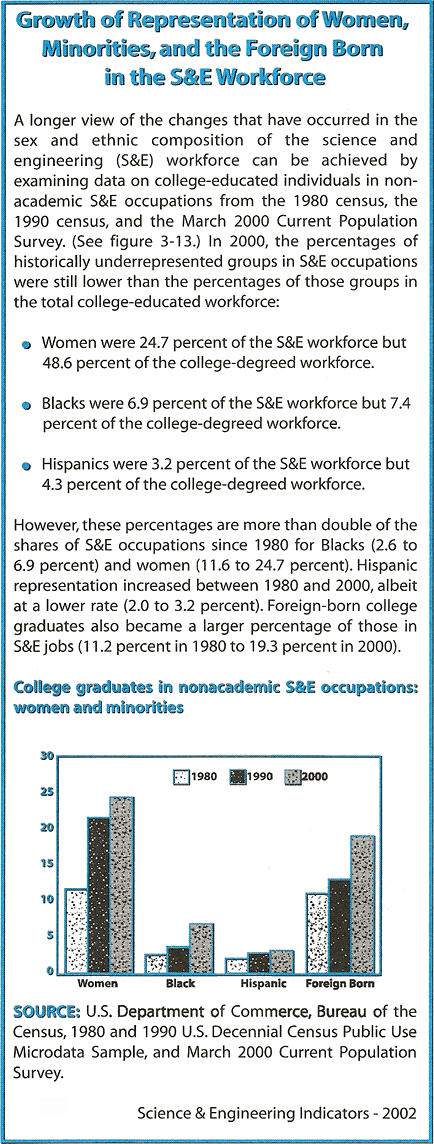
Data made available on March 6, 2001, tell us that “the proportion of the Hispanic population age 25 and over with at least a bachelor’s degree ranged from 23 percent for those of Cuban origin to 7 percent for those of Mexican origin, according to survey data collected in 2000 and released… by the
Commerce Department’s Census Bureau.” There is a note of caution by the Census Bureau, to wit, these are estimates, collected in the March 2000 current population survey (CPS), and should not be confused with the Census 2000 results, which are scheduled for release over the next three years.
Checking the educational attainment of the Hispanic population, 25 years old and over, by type of origin, for the years 1985 and 1989, I found that for the Cuban population, there has been a steady rise in the percentage that have completed four years of college or more. In 1985, 13.7 percent of Cubans had at least a bachelor’s degree; in 1989, 19.8 percent; and in 2000, 23 percent. For
Mexican-Americans, 5.5 percent in 1985, 6.1 percent in 1989, and 7 percent in 2000, a slower rise for Mexican-Americans, but one must consider that Mexican-Americans represent a larger population. For example, in 1989, there were 790 Cubans with at least a bachelor’s degree, but at the same time, 5,931 Mexican-Americans with bachelor’s degrees. This does not mean that we should be content with what is obviously low representation of Mexican-Americans.
Mexican Stereotypes Holding Firm
Reviewing a report in The San Francisco Chronicle on the 2000 Census for information on professionals from Mexico, I read the following:
“…For immigrants who come from poor countries with scant educational opportunities, however, job prospects in the United States can be limited. Mexicans from rural areas, for example, lack an education that has kept up with changes in technology,” said Abdiel Onate, a professor of Latin American History at San Francisco State University…“They do all the menial jobs, here,” he said. “All the labor in the kitchens of the restaurants in the Bay area, installing telephones, landscaping, gardening, construction work. Without their labor, things would be much more expensive.”
This quote speaks for itself. There is little or no mention of Mexican-American professionals. There is still the focus on the stereotypical image of the Mexican-American as being uneducated.
The article does mention that Terry Alderete, vice president of Alameda County’s Hispanic Chamber of Commerce and chief of operations for the unity council, a community development agency, “has seen a wide range of new Mexican immigrants arriving in Alameda County over the past decade,
from day laborers to business people with capital to invest…”
No mention was made of education levels that would indicate Mexican-American professionals.
But an article in the Austin American Statesman; July 12, 2001, quoting a relevant study, said: “Mexican immigrants in the U.S. are better educated than widely believed, more urban, and increasingly more likely to settle in Texas than in California… [I]t challenges long-held stereotypes and is raising concerns in Mexico about a brain-drain flowing north…. [T]he migration of highly educated Mexicans ‘has a high cost for the development of Mexico, and their loss weakens all of society.’ ‘It implies the transfer of a valuable human resource, in which our country has made a substantial investment.’ About 6 percent of all Mexicans older than 20 who have college or postgraduate (SIC) degrees now live in the United States… Mexican demographers said the study’s findings confirm anecdotal indications that they have seen for years of migrant trends shifting from rural to urban and from unskilled to professional. They attributed the brain drain to Mexican oversupply meeting with U.S. demand.”
A Phoenix/Tucson Study
Dr. Ramona Ortega-Liston published in Public Personnel Management a very interesting article entitled “Mexican-American Professionals in Municipal Administration: Do They Really Lag Behind in Terms of
Education, Seniority, and On-The-Job Training?”
The related study took place in the cities of Phoenix and Tucson.
“Separation of data by ethnicity and nativity distinguishes this study from previous research that includes all Hispanics,” she wrote. “First, Mexican nationals were separated from Mexican-Americans. Second, Mexican-American professionals were separated from all other Spanishsurnamed ethnic groups. The need for separating data by ethnicity and nativity has been recommended…because it may yield a more accurate profile of each ethnic group on specific variables examined.” She should
be applauded for this great insight but gives credit in her footnotes to others who have advanced this strategy. She also concluded that at least for that study group in Arizona, “Mexican-American managers do not appear to lag behind on important career variables such as seniority, education,
and on-the-job training…”
Science and Engineering
The National Science Foundation, in its Science and Engineering Indicators 2002, Vol. 2, reports that in 1999 there were 31,700 foreignborn (Mexican) U.S. residents with science and engineering degrees. This number does not include individuals with only foreign degrees who were not in the U.S. in 1990. Although this sounds like a great many, the total number of U.S. scientists and engineers in 1999 was 13,003,900. The total of foreign-born scientists and engineers is less than 1 percent.
The number of recipients of doctorates from U.S. universities who plan to stay in the U.S. and were born in Mexico remained steady, varying from 10 in 1996 to 11 in 1999.
There is no separate number for Mexican-Americans, but the total number of Hispanic science and engineering grads with earned bachelor’s degrees has grown from 9,268 in 1977 to 26,725 in 1999. Still a small fraction of the total science and engineering graduates.
By coincidence, Dr. Diana S. Natalicio, the president of my alma mater, the University of Texas at El Paso (UTEP), is a member of The National Science Board, which submits biennial science indicators and science and engineering indicators, in accordance with Sec.4(J) of the National Science Foundation Act of 1950, to the president and Congress.
It is gratifying to read that UTEP is involved in the training of engineers who work for the factories located in Ciudad Juárez, Mexico. This industry has grown to 3,500 plants along the 2,000-mile border that take advantage of cheaper labor in Mexico and the North American Free Trade Agreement
(NAFTA). UTEP has started a weekend graduate engineering program for advanced-level factory employees. About 100 engineers are participating.
Breaking Stereotypes
Hector De Jesús Ruiz, CEO of Advanced Micro Devices, is a Mexican-American engineer who represents the continuing change in our Mexican-American community. He was born in Piedras Negras, Mexico, and has a degree in electrical engineering from the University of Texas at Austin. He
tells us that what helps him get through tough times is a memory from when he was 14 years old. He recalls that “a politician was on the radio proclaiming that he represented the party of the poor and the destitute. My father said, ‘Son, when you grow up, I don’t want you to be a member of a
party that caters to the oppressed and the poor. You have to aspire to be a member of a party that is happy, winning, and influential.’” Ruiz adds that the experience stuck with him and says that he does not want to be the underdog–he wants to try to figure out how he can win big.
Conversations Across the Border
During my last visit to Ciudad Juárez, Mexico, I had the opportunity to visit a private college and prep school where my niece, Cecilia Valdez, is a teacher and administrator.
The campus is very modern, with some of the newest advances in technology that money can buy. At this institution, students are prepared for the job market in Mexico and in the U.S. The curriculum reflects both markets.
The school’s coordinator of international programs informed me that the school offers student exchange programs with Boston University, Purdue, University of British Columbia, and many other schools of higher learning throughout the world. The curriculum is accredited by the
Southwestern Association of Colleges and Universities. The coordinator told me that as many as 42 students transfer to the University of Texas at El Paso, located just across the border. The reasons for their transfer vary and include curriculum and finances. Some career tracks are not offered
at the college. Some students at the school are U. S. citizens and for them it is cheaper to attend UTEP.
I asked her about the factories along the border established through NAFTA, referred to in Mexico as “maquilas.” She told me that maquilas bring in their own professionals, according to the needs of each company. Obviously, they are a great source for all types of jobs along the border with Mexico. She had knowledge of a number of graduates who felt that there still exists prejudice against the foreign-born when applying for work in the U.S. The visa process is lengthy and costly. Her own brother, now working in Kentucky as an engineer for a Mexican company, would like to relocate in Mexico, she said.
During my visit, I also had the good fortune to talk with the coordinator of science programs for the college, who spoke about her very successful sons, both of whom work in the U.S. Her oldest earned his master’s degree from UTEP in engineering communications and studied his high school (preparatoria) in Mexico. He is now a successful design engineer in Newport Beach, Calif. Through his good academic record and teacher recommendations, he was able to qualify for a resident passport in the U.S. Her younger son was a business administration major at UTEP and earned an M.A. in accounting. He now works for El Paso Energy in Houston, Texas, and is married to a U.S. citizen, which allows him to file for his own U.S. residency.
In both situations, the quality of their lives in the U.S. far exceeds the one they would have experienced in Mexico, according to their mother. They are well adjusted to the competitive life in the U.S. and have proved that they can succeed in the U.S.
It is important to state that UTEP’s enrollment includes 1,749 students from Mexico, a 4 percent increase over last year. According to Natalicio, “These students represent approximately 15 percent of all Mexican nationals enrolled in the U.S. colleges and universities…”
Epilogue
I would like to encourage social researchers to separate data that refer to Mexican-Americans. It will help us assess the progress or lack of it of our Mexican-American community. Also, the persons who report the news in the media need to be more sensitive to patronizing and stereotyping.
My thanks to Walter Gilmore for his ideas, and to all the reference librarians at Sánchez Library, Pacifica, San Francisco State, and Skyline College. To all of you, a big Mexican hug.
References
Tyche Hendricks, “All Roads Lead to the Bay Area”, Associated Press, San Francisco Chronicle, Aug. 27, 2002, p. A12
Census Bureau SIC 926110, “Diversity of the Country’s Hispanics Highlighted in the U.S. Census Bureau Report, U.S. Newswire; March 6, 2001.
Pinto Alicea, Ines. Chapa, Flores, and Yzaguirre Press for Equity. Latino perspective on census 2000. Hispanic Outlook in Higher Education, Sept. 10, 2001 V.11; N.24 p 20.
Science and Engineering Indicators-2002. Vol. 2 p.A2-23 Garwood, Alfred. Hispanic Americans, a Statistical Sourcebook, published by Numbers and Concepts, 1991. Boulder, Colo. p. 132
US. Newswire, March 6, 2001.
Nova, UTEP Alumni Magazine. Winter 2002. p. 8
Lynn Elber, Associated Press, San Francisco Chronicle, Friday, Aug. 16,
2002, p. D 18.
San Francisco Chronicle, Aug. 27, 2002, p. A12
Susan Ferriss, American-Statesman International Staff, Austin American
Statesman; Austin, Texas; July 12, 2001, p.A4.
Ramona Ortega-Liston, “Mexican-American Professionals in Municipal Administration: Do They Really Lag Behind in Terms of Education, Seniority, and On-the-Job Training?” Public Personnel Management,
Summer 2001 V30 12 p. 197.
Science and Engineering Indicators-2002, Vol., 2, National Science Foundation, p.A169.
About the Author
Humberto Gutiérrez holds a B.A. in philosophy from UTEP, an M.A. in administration and supervision of education from CSU-Northridge, and was a doctoral candidate in both romance linguistics and philosophy of education at UCLA. His career in education spans three decades and includes teaching people of all ages, elementary and high school through college. He has developed and taught bilingual and multicultural programs at Mendocino College and throughout the L.A. Unified School District. Publications include Spanish for Our Schools and Spanish Developmental Reading Program, both for the L.A. City Schools, and Mexican-American History, for the Hispanic Urban Center.


